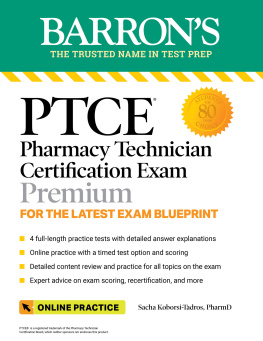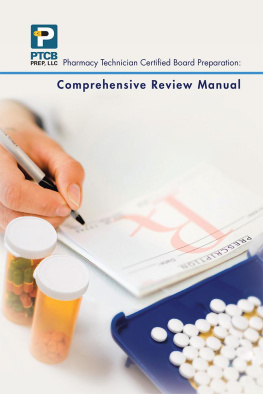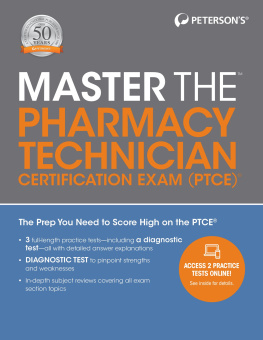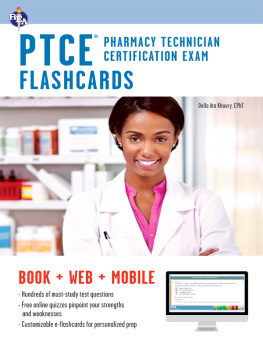CERTIFICATION
REVIEW FOR
PHARMACY
TECHNICIANS
NINTH EDITION
NOAH REIFMAN, R.Ph., MS


AuthorHo usew
1663 Liberty Drive
Bloomington, IN47403
www.authorhouse . com
Phone: 1-800-839-8640
Copyright-1994,1996, 1997, 1998, 2000,2005, 2008, 2012-Noah Reifman, 9th Edition
No part of this book may be reproduced, stored in a retrieval system, or transmitted by any means without the written permission of the author.
First published by AuthorHouse 12/6/2011
ISBN: 978-1-4685-0730-0 (sc)
ISBN: 978-1-4685-0729-4 (e)
Printed in the United States of America
ABOUT THE AUTHOR
Noah Reifman, R.Ph.,M.S., a consulting pharmacist since1989, graduated from the Schwartz College of Pharmacy in 1980. He received his Masters from Temple University in Pharmacology/Toxicology. Noah has been involved in the education of pharmacy technicians for the past ten years in all areas of the ASHP Model Curriculum Competencies. He was the Director of the ASHP-Accredited Pharmacy Technician Program at Arapahoe Community College in Littleton, Colorado and was elected president of the Pharmacy Technician Educators Council (PTEC) in 2001. Noah has also authored a competency-based pharmaceutical mathematics text/workbook MATHMASTER PHARMACEUTICAL CALCULATIONS FOR THE ALLIED-HEALTH PROFESSIONAL (3rd edition). He also produced two educational videos on Reducing Medication Errors and Medication Administration. His interactive, online Certification Review Course was launched in 2006 (arkpharm.net).
Contibuting Author and Editor:
Jessica A. Trujillo, Pharm. D.
CONTENTS
Enhance Your
PTCB Exam Success
Include our Online Certification Review Course
and Pre-Testing Tools
Organized study plan
Key test-taking strategies
Proven learning techniques
Proven strategies for remarkable score-raising
Flexible study program that adapts to your study habits
Practice exams with evaluation of personalized strength/weaknesses
CONTENTS
- Six online review sessions covering all topics needed to excel on the exam. - Math Master-Pharmaceutical Calculations 3rd edition. - Five Certification-like practice exams with online grading and strength/weakness trending. - Post section Proficiency Exams assessing your progress.
arkpharm.net
Visit this LINK to purchase or take our free virtual
tour of the course!
http://arkpharm.net/mspecials_onlinecourse.htm
By purchasing the new 9th edition of Certification Review for Pharmacy Technicians, you are eligible for an upgrade to our interactive, online Certification Review Course.
TIPS ON TAKING THE CERTIFICATION EXAM
1) PLAY the percentages by eliminating as many wrong answers first and then deciding on a correct answer. This will increase your odds of answering the question correctly. With four possible correct answers, by eliminating two possible answers you have increased your odds from 1 in 4 to 1 in 2. 2) PACE yourself properly by first answering all the easy questions and then returning to tackle the hard ones. The National Certification Examination contains 100 multiple choice questions. 3) DONT work so fast that you start making careless errors or too slowly that you are left with a shortage of time. You are given 2 hours to complete the National Certification Exam. To insure proper use of this time, bring an accurate watch to the exam in case the room does not have a clock. 4) ANSWER all questions on the exam. A blank space on your answer sheet is automatically considered a wrong answer, so even a random guess increases your odds and may ultimately increase your score. 5) CHANGE answers only if you have a reason for doing so. Last minute changes have been shown to have a negative effect on test scores. 6) BEWARE!! Most standardized exams stack harder questions in the beginning of the exam to possibly disturb the candidates concentration and psyche. If the first few questions seem overly difficult, skip over them and return to them at a later time. Remember that many times, future questions on an exam provide vital information for previous questions. 7) READ all answer choices before you decide on the correct answer. Watch out for answer choices designed to tempt the candidate into guessing incorrectly. 8) USE good judgement and best of luck.
A DRUG is a substance intended for use in the diagnosis, cure, treatment or prevention of disease in human beings or animals.
Drugs are available both by prescription and non-prescription.
1) LEGEND DRUGS a) refer to those medications that REQUIRE a prescription. b) legend refers to the phrase on every manufacturers prescription drug stating CAUTION: FEDERAL (USA) LAW PROHIBITS DISPENSING WITHOUT A PRESCRIPTION. c) not considered safe for use without medical supervision. 2) OTC DRUGS a) refer to those drugs that DO NOT REQUIRE a prescription. b) the letters OTC mean OVER THE COUNTER . c) considered safe for use without medical supervision.
THE PRESCRIPTION ORDER: COMMUNITY PRACTICE
A prescription is an order for a medication or medical device, issued by a licensed prescriber.
a) licensed prescribers include the physician, dentist, veterinarian, podiatrist, physicians assistant and nurse practioners. b) Nurse Practioners and Physicians Assistants may also prescribe under the direct supervion of a licensed prescriber . c) only a licensed pharmacist or pharmacy intern may receive a telephone prescription from the above legal prescribers. d) pharmacy technicians may not transcribe telephone orders directly from the prescriber but may record authorized refill information including patient name and address, Rx number, date of original prescription, and pick-up or delivery times. This may change in the near future.
PARTS OF THE PRESCRIPTION ORDER:
1) PRESCRIBER INFORMATION a) name of prescriber must be imprinted on prescription order. b) address and phone of prescriber. c) Drug Enforcement Agency (DEA) number for controlled substances. d) State License number for certain 3rd party prescriptions. 2) PATIENT INFORMATION a) name and address of patient. b) age of patient. c) date the prescription was prescribed for the patient.
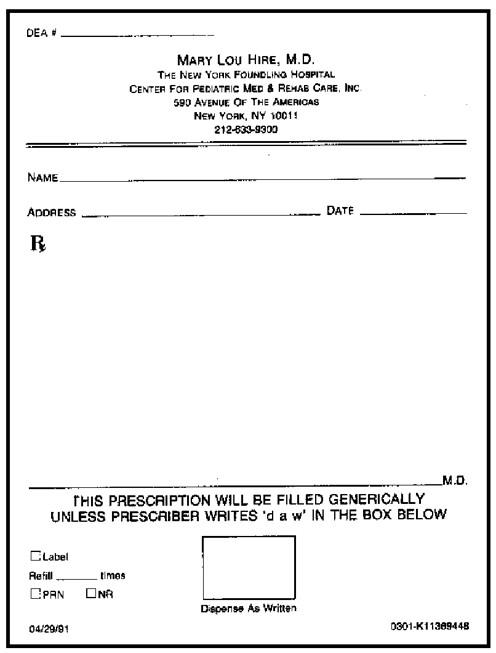
3) MEDICATION INFORMATION
a) name, strength, dosage form, quantity and directions for use. This is referred to as the dispensing directions. b) signature of prescriber indicating if BRAND or its GENERIC EQUIVALENT should be dispensed. c) indication as to the number of refills. If no refills are authorized, then the prescriber may indicate this fact by using the letters NR.
BRAND, GENERIC, CHEMICAL NAMES:
1) BRAND or TRADE NAME a) designated by a superscript at the end of the drug name, indicating it has been registered with the US Patent Office. b) only the patent holder may use the trade/brand name of the drug. c) a brand name distinguishes a particular product from those of its competitors. d) if a brand drug is desired, the prescriber will indicate this fact by writing in the appropriate space DAW, Dispense As Written. 2) GENERIC NAME a) is often a contraction of the chemical name, sometimes indicating the chemical class to which the drug belongs. b) if DAW is not indicated, then the generic equivalent will be dispensed. c) is properly referred to as its nonproprietary name. 3) CHEMICAL NAME a) describes the structure of the drug by standard chemical nomenclature.
GENERIC SUBSTITUTION:
Next page


